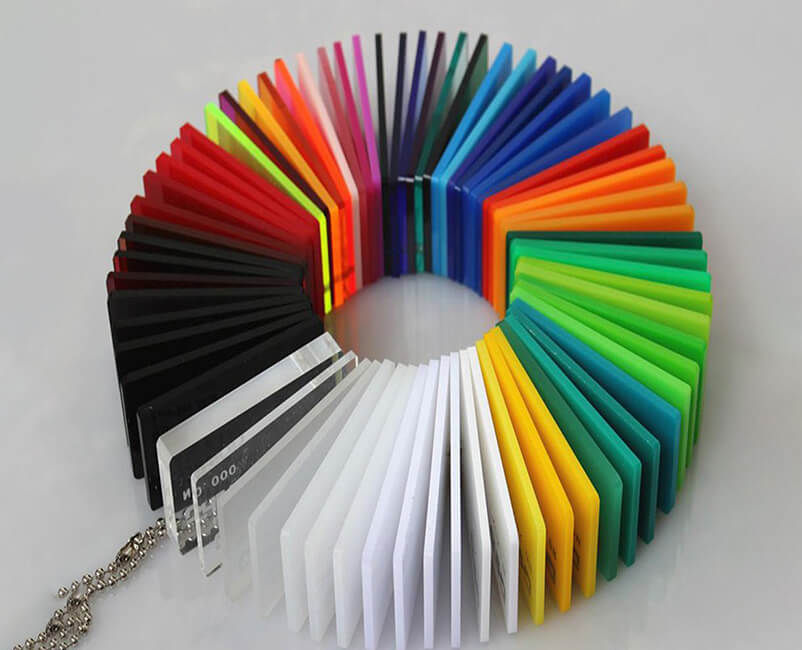The requirements for the thickness, transparency, and weather resistance of Color Acrylic Sheets vary significantly depending on the specific application scenarios. These properties are essential for ensuring that the acrylic sheet performs well, meets safety standards, and achieves the desired aesthetic or functional result.
The thickness of Color Acrylic Sheets is primarily influenced by the intended application, the structural load it needs to bear, and its exposure to physical forces (such as impact or pressure).
In applications like storefront signs, billboards, and advertisements, the acrylic sheet usually requires a thickness of 3mm to 10mm. Thicker sheets are often used for larger signs or those exposed to high winds and environmental stress. Thicker sheets offer more durability and prevent bowing or warping over time.
For home decor, furniture, or partition walls, a typical thickness range is 3mm to 8mm, depending on the size and the level of transparency required. Thicker sheets (above 8mm) may be used in pieces like tables or shelves that require additional support and strength.
Acrylic sheets used in light diffusers or LED light panels usually require a thickness of 2mm to 5mm to allow optimal light transmission while maintaining structural integrity. Thinner sheets are preferred for uniform light diffusion without excessive material bulk.
For protective screens or barriers, such as in airports or medical settings, the acrylic sheet needs to be 6mm to 15mm thick to offer adequate impact resistance and durability while still being transparent for visibility.
The level of transparency required from Color Acrylic Sheets depends on the application’s need for light diffusion or the aesthetic effect desired.
For signage that requires vibrant colors and clear visibility, acrylic sheets should ideally be clear or lightly tinted to allow for maximum light passage. However, for backlit signage, frosted or opaque sheets can be used to diffuse light evenly across the surface.
In decorative applications (e.g., wall panels, shelves, and light fixtures), transparency may vary. For instance, frosted or semi-transparent acrylic sheets are often preferred in partitions or privacy screens to provide some visual separation while still allowing some light to pass through.
For furniture pieces like tables, shelves, or display cases, clear acrylic is typically preferred to maintain visibility, especially in high-end or luxury design. However, colored or opaque acrylic can be used for aesthetic effects, as in sculptures, decorative accents, or unique furniture designs.
Acrylic sheets used for light diffusers generally require high transparency to ensure efficient light transmission. Transparent or semi-transparent sheets help in distributing light evenly, particularly in LED backlit panels.

Weather resistance is crucial for applications where the acrylic sheet will be exposed to the elements. The primary factors include UV stability, impact resistance, and resistance to environmental degradation (e.g., fading, cracking, or yellowing).
Acrylic sheets used for outdoor signage need to have excellent weather resistance. These sheets should be UV-resistant to prevent yellowing or fading over time, and weatherproof to withstand exposure to sun, rain, wind, and varying temperatures. A UV-stabilized acrylic sheet with a high degree of weather resistance is typically required, with thicker sheets preferred for enhanced durability, usually 4mm to 12mm thick.
Acrylic sheets used in curtain walls, skylights, or windows are often exposed to harsh weather conditions. To ensure longevity and transparency, these sheets must be UV-stabilized and have excellent resistance to temperature fluctuations. They should also be thicker, generally in the range of 5mm to 15mm, to resist impact and pressure while maintaining clarity and aesthetic appeal.
For outdoor furniture or decorative items like garden sculptures or water features, weather-resistant acrylic with UV protection is required. This ensures the color does not fade or degrade under prolonged sun exposure. Thicker sheets may be required for larger, more exposed structures, typically around 6mm to 10mm.
In applications where acrylic is exposed to salty air, high humidity, or extreme UV rays (e.g., in marine or coastal environments), highly weather-resistant acrylic sheets with extra UV protection are necessary. These acrylics are typically treated or co-extruded with a special coating to protect them from degradation, ensuring the color and transparency remain intact over time. Thicknesses here might range from 8mm to 15mm, depending on the specific environmental stresses.
The thickness, transparency, and weather resistance of Color Acrylic Sheets must be chosen based on the specific application and the environmental conditions they will be exposed to. For indoor applications like interior design, lower thicknesses and varying transparency levels may be acceptable. However, for outdoor signage, furniture, or environments exposed to harsh weather, thicker sheets with excellent UV stability and weather resistance are essential. Choosing the right combination of these properties ensures the durability, functionality, and visual appeal of the acrylic product.
 English
English 中文
中文 Español
Español


